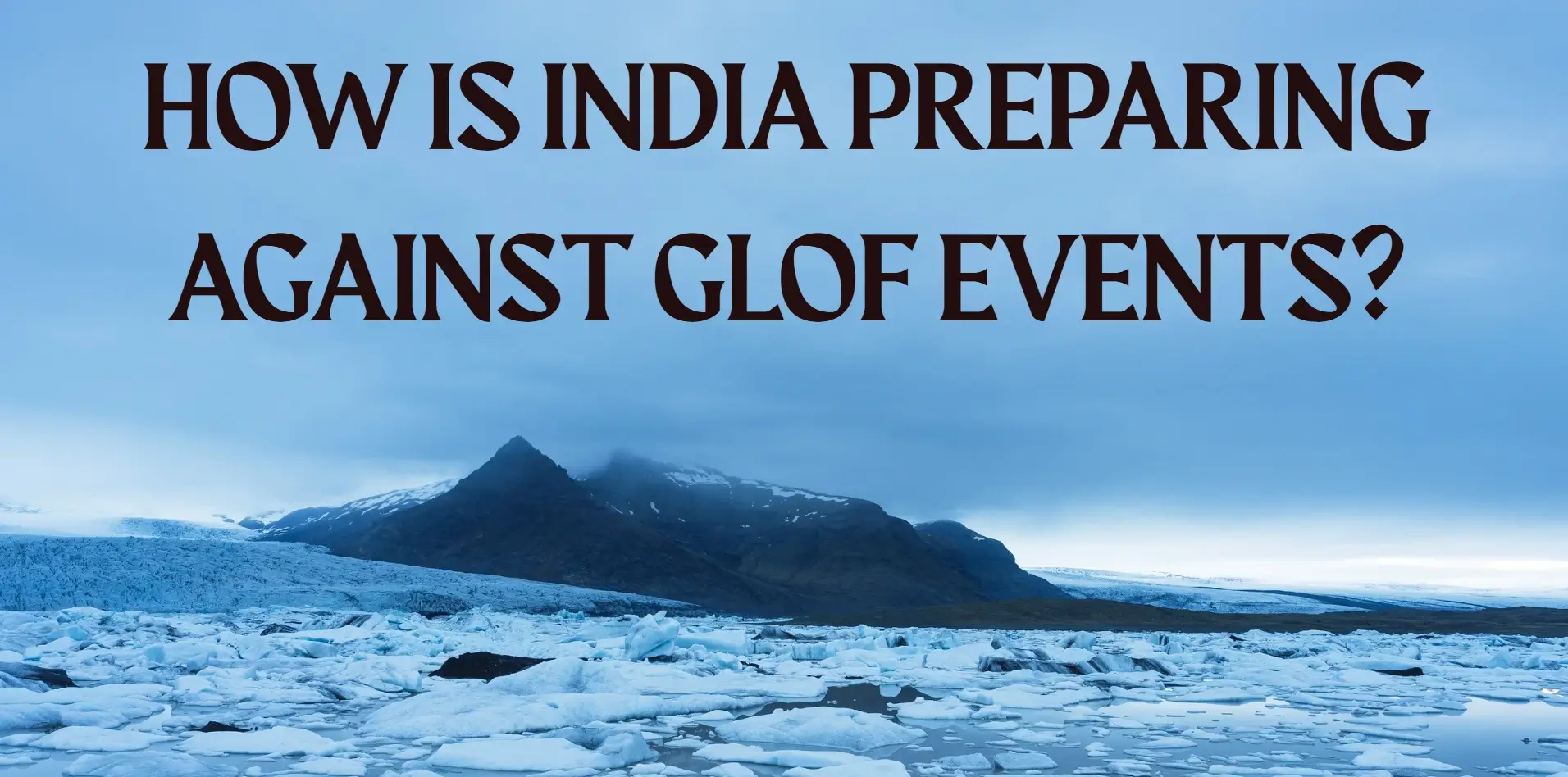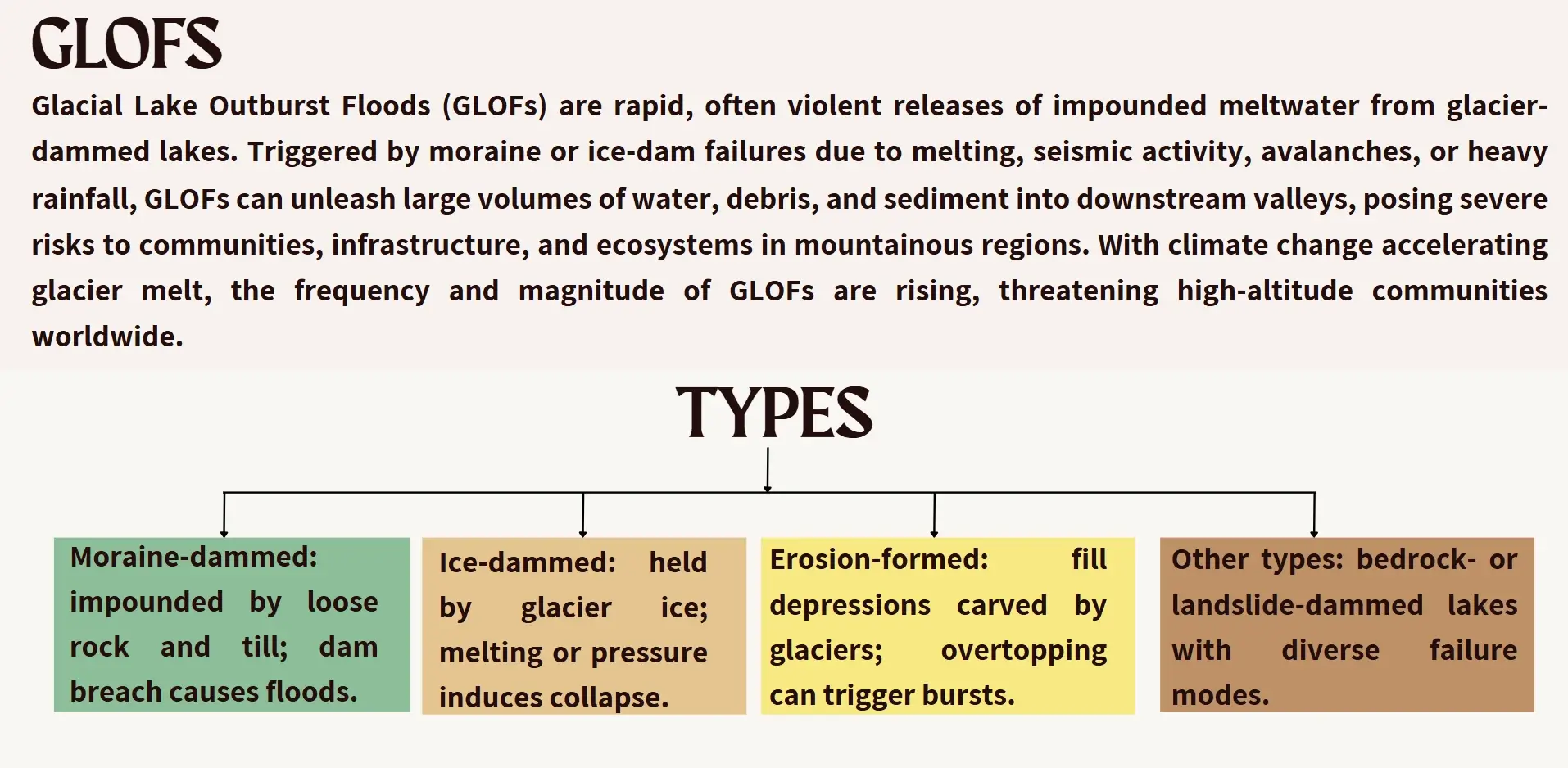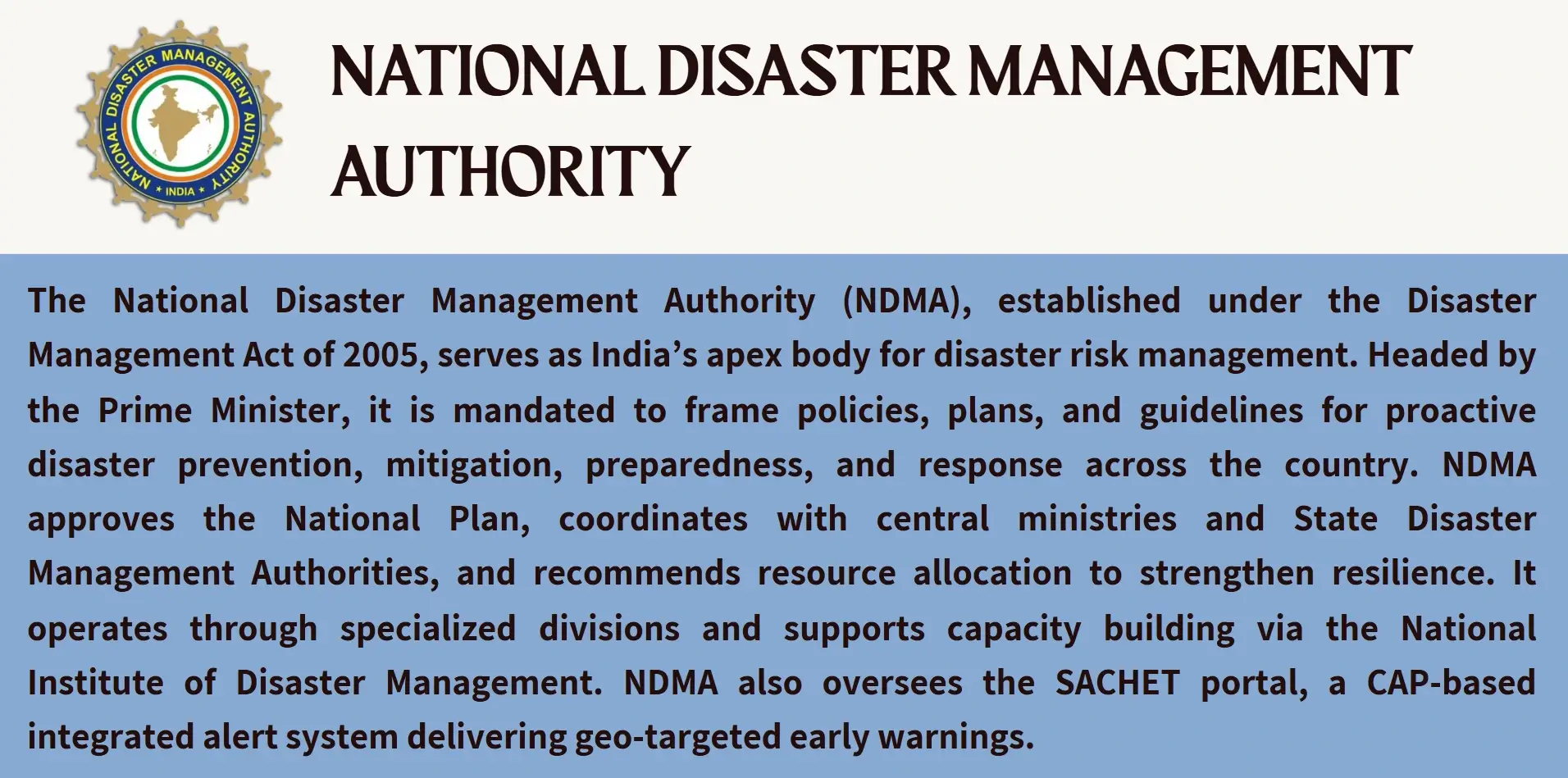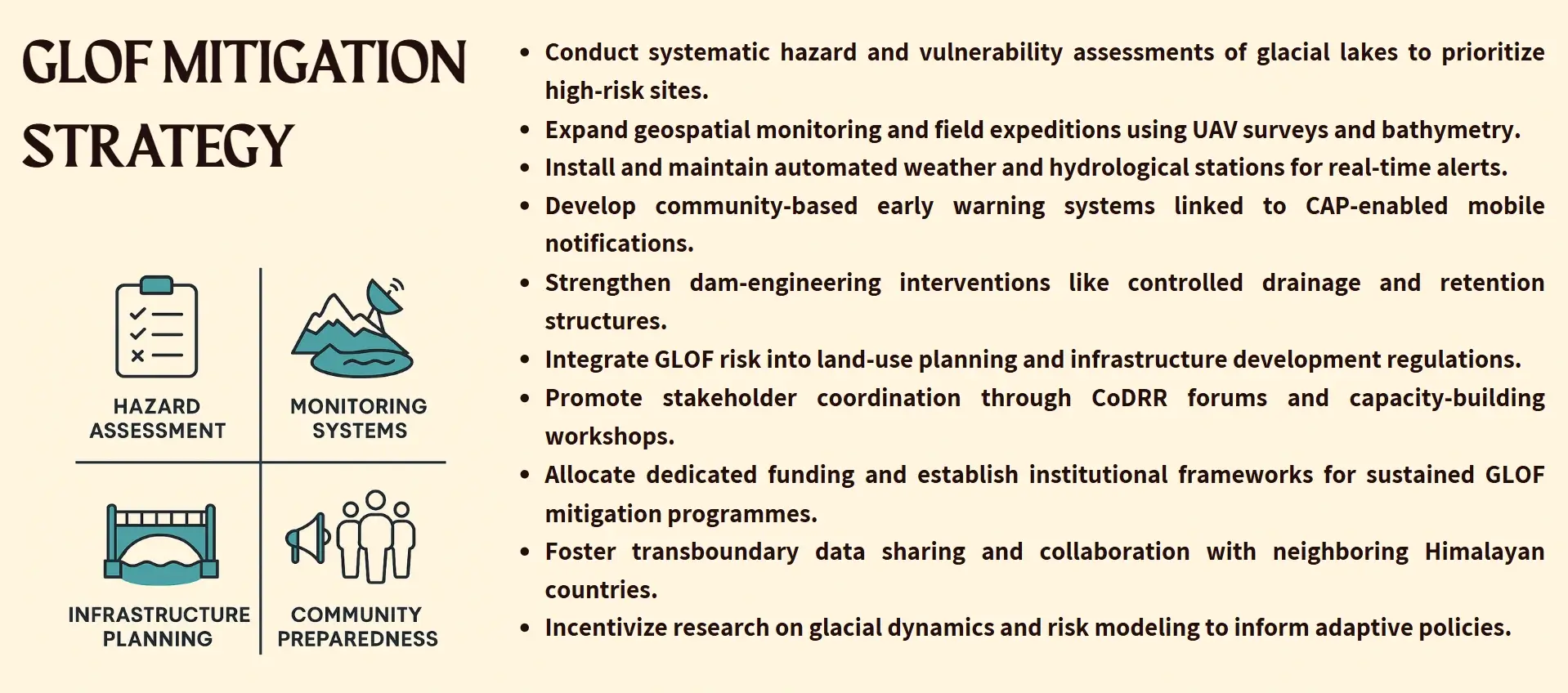India is overcoming the hazard of GLOF by conducting glacial lake surveillance, early warning services, and the involvement of NDMA whereas Nepal is experiencing regular GLOF calamities.

The Glacial Lake Outburst Floods (GLOFs) have become an emergency threat in the Indian Himalayan Region (IHR) due to rapid melting of glaciers and climatic changes due to impacts on high mountain terrain landscapes. Such quick floods are brought when glacial lakes burst their natural or moraine-built dams and unleash floods that wipe up downhill infrastructures and settlements. The Himalayas have more than 28,000 glacial lakes in its region all the way to the Himalayas, and the potential for that melt is therefore enormous, and trans-boundary in nature, particularly in countries such as India and Nepal with delicate mountain ecosystems and mounting threats to hydropower facilities, roads, and human population centres.GLOF events in Nepal in recent times, Solukhumbu to Lende, make it clear as to how crucial it is to have cross border early warning systems and Cross cross-border mitigation strategy. With respect to that, India is also promoting an aggressive framework within the National Disaster Management Authority (NDMA) that combines remote sensing, vulnerability mapping, real-time monitoring, and community preparedness to protect high-frequency areas. The article addresses the science of GLOFs, major mitigation methods, regional collaboration difficulties,and the contribution of the National GLOF Risk Mitigation Programme of NDMA in dealing with upcoming dangers. Since climate change is pushing glacial processes toward a higher level, any knowledge and action on GLOF hazard is core to India disaster resiliency and environmental security in the Himalayas.
Knowledge of GLOFs in the Himalayas
Glacial Lake Outburst Floods (GLOFs) are sudden and high magnitude floods caused by the bursting of glacial lakes. They pose an increasingly menacing challenge to Himalayan towns and villages, infrastructure and nature.

Development and Triggers of GLOFs
GLOFs are incidences that are formed due to the breakage of natural ice melts on lakes, or the dam breaching of a lake as a result of over spinning built moraines. The most common types of triggering are those that involve ice avalanches, land-sliding into the lake, earthquakes, sporadic snowmelt or internal breakdown of ice-cored moraines. The released floodwaters can run tens of kilometres causing destruction to everything down the flow within a few minutes.
Special susceptibility of the Himalayas
The Himalayas contain one of the most extensive glacial lake systems in the world, having more than 28,000 lakes being mapped in India-Nepal-Bhutan and Tibet. Most of them are located beyond the 4,000 mark where the pace of melting has increased because of a rise in temperatures. The topography of steep ravines and weak geology builds more on the exposure of downstream locations as well.
Impact in the region and transboundary risk
The GLOF threats are in themselvestransboundary. As an example, lakes in Tibet have led to outburst floods that have affected the villages of Nepal and India and the hydropower stations. The closeness between river basins included in the same glacial catchment and the interdependency of these factors requires information sharing across borders, cross-border early warning systems, and collective response plans, whose major part is still in development.
Natural Hazards towards Climatic Emergencies
Although GLOFs have not always been severe and frequent, their characteristics are increasingly becoming more frequent and unpredictable with climate change. The occurrences of any events such as the 2013 Kedarnath flood and the 2023 Sikkim disaster indicate that the focus of events has shifted to climate emergencies, contiguous in nature. This highlights the dire necessity of forward-looking risk hazard and local strength measures in the Himalayas.
The Recent Happening in Nepal of GLOFs
With more than 2000 glacial lakes lying in between the central and eastern Himalayas, Nepal has experienced a very sharp rise in the number of GLOFs in the last couple of years.
- Such eruptions have revealed the precarious combinations of environmental susceptibility against the infra-structural expansion in the high-altitude landscapes.
- In July 2025, a flash flood on the Tibet side of Lende River basin rushed towards Nepal and destroyed Mustang and Humla districts severely.
- A previous moraine-dammed lake in a different location in the Thame village in Solukhumbu district ruptured in the year 2024, causing a destructive flood, sweeping away footbridges, ruining the trails, and endangering downstream hydropower developments.
- These incidents not only destabilised local communities but also brought out the loopholes in the surveillance and early warning systems in the mountain passages in Nepal.
- Most of the high-altitude lakes are heavily unmonitored despite increasing risks. Inadequate access to real-time data,difficult terrain, and an insufficient disaster response mechanismhave limited preparedness in Nepal.
- The majority of glacial lakes located close to the border are prone to upstream destabilisationby Tibet, which makes it even more necessary to provide transboundary collaboration on risk mapping, satellite monitoring, and warnings.
The experience of Nepal demonstrates the critical need for coordinated risk management, enhanced regional strategies of data-sharing and community-based resilience planning in order to address the nationwide GLOF crisis.
Types of Glacial Lakes inthe Indian Himalayan Region
The Indian Himalayan Region (IHR) is the abode of more than 28,000 glacial lakes that have evolved over the last centuries through glacial recession and climatic changes. All these lakes differ in terms of origin, formation, and exposure to outburst activities.
Moraine-Dammed Lakes
These arethe most common and dangerous in kind. They are created when receding glaciers deposit heaps of materials, known as moraines, that serve as natural dams. Such dams have lumps of ice ripe in them along with loose sediments, which makes them unreliable. These barriers can be punctured by sudden events such as avalanches or seismic tremor, resulting in Glacial Lake Outburst Floods (GLOFs) that are disastrous. Such a lake failure was connected to the 2023 Sikkim flood.
Supraglacial Lakes
These can be seen on the glaciers as they take formation above the surface of the melting glacier. They normally are seasonal and shallow; they grow very fast during summer. They accelerate the melting of glaciers by heating in the sunlight since they have a lowervolume than the moraine-dammed ones. These lakes are free to merge or drain themselves, causing a glacier to become unstable and pose greater flood risks downstream.
Erosion and Ice-Dammed Lakes
Glacial movement gets rid of depressions into bedrock, which form erosion lakes. Even though these were structurally more stable, they would still be dangerous in case they were placed where there are steep slopes or they intersect an active fault line. Glacial ice itself impounds the ice-dammed lakes. These are quite unusual in the IHR and very unpredictable, just as melting or subdividing ice may discharge substantial amounts of water in the most unforeseen moments.
Mapping and Surveillance Activities
Glacial lakes have been categorised by The National Remote Sensing Centre (NRSC)on the basis ofsatellite data in all over the Indus, Ganga, and Brahmaputra basins. Moraine-dammed lakes predominate, followed by lakes that have been eroded, supraglacial, and ice-dammed. Such classification can help in prioritising the GLOF risk assessment and disaster preparedness.

The Risk Landscape of India
Increasing threats to the Himalayan range of India due to Glacial Lake Outburst Floods (GLOFs) are mainly due to the dangerously accelerated melt and the unpredictable climatic trends.
- The problem is not only that there are more than 7,500 glacial lakes above 4,500 meters of which many lie in inaccessible areas, but that identifying them can only be a part of the problem. Such states as Sikkim, Uttarakhand, and Himachal Pradesh are especially vulnerable, and dams, roads, and hydropower plants are built downstream of unstable lakes.
- The sample used was the 2023 breach of Chungthang dam in Sikkim that caused a cascading effect of the single lake breach; power supply was disrupted, people vacated, and national properties were damaged. Ground-level monitoring is sparse although ISRO and the NRSC map the ground by satellites to obtain data on ground-level movements in the region of the plate.
- Seismic activities, harsh topography, and cloudbursts during the seasons further add complexity to the risk landscape of India and can either initiate or complicate GLOF events. The vulnerability is increased by the absence of the integrated early warning systems of the cross-state borders and the low level of community awareness.
- In the light of acknowledging these threats, India is shifting from areactive approach to the disaster response to a proactive approach to risk mitigation. Hazard mapping, real-time surveillance, and inter-agency coordination have taken center-stage as some of the priorities at the National Disaster management Authority (NDMA) to reduce GLOF risks as part of its resilience in high-altitude areas.
Mitigation strategy of NDMA
The revolution that has changed disaster response in India and made it more positive is a paradigm shift in attitude by the National Disaster Management Authority (NDMA) to approach disasters in a proactive manner of risk mitigation rather than reactive approach of disaster response, particularly in the scenario of climatic induced hazards such as Glacial Lake Outburst Floods (GLOFS).
Prevention as a Strategic Change
The strategy associated with NDMA is concerned with preparedness, resilience, and prevention. It falls under the Disaster Management Act of 2005, and it organizes national works to mitigate the vulnerabilities by mapping the hazards, early warning systems, and community initiatives. This change is in tandem with the Sendai Framework of Disaster Risk Reduction, with which India has internalised as an orientation factor.
National GLOF Risk Mitigation Programme(NGRMP)
In an effort to deal with the GLOF-specific risks, NDMA has established the National GLOF Risk Mitigation Programme (NGRMP),a 20 million dollar project aimed at mitigating the risk of 195 glacial lakes of High Risk in the Indian Himalayan Region. The programme will entail:
- Automated Weather and Water Stations (AWWS) installation
- Installations of Early Warning Systems (EWS) in threatened valleys
- Bathymetric and geophysical surveys to assess lake stability
- Disaster preparedness and evacuation drills are done by the community
Such measures are to decrease downstream threats to structures and people.
Technology and Multi-Agency Coordination
NDMA works with the ISRO, NRSC, IMD, and DRDO to incorporate satellite remote sensing images, Synthetic Aperture Radar (SAR) and Electrical Resistivity Tomography (ERT) with its monitoring system. Aggregated data on pilot stations in Uttarakhand and Sikkim go into centralised dashboards to make quick decisions in real time.
Institutional and Regional Partnership
The authority also collaborates with the State Disaster Management Authorities (SDMAs), the Central Water Commission, and international partners such as Nepal and Bhutanin order to support trans-boundary cooperation. Joint work and joint tapping-sharing protocols are being fashioned out to overcome common glacial dangers.

Challenges and Gaps
Numerous floods continue to challenge India in its measures to prevent Glacial Lake Outburst Floods (GLOFs) despite the increased awareness.
- The significant gap is the scant coverage of high-altitude lakes under real-time monitoring systems. A large number of glacial lakes are not instrumented because of inhospitable terrain, logistical issues, and funding, which places communities at risk of being devastated by abrupt lake ruptures.
- Another serious deficiency is in the area oftransboundary coordination. In Tibet and Nepal, lakes regularly affect downstream areas of India, but guidelines relating to sharing information and establishing coordinated early warning systems are immature. Lack of formal hydrodiplomacymechanisms negatively affects the timely alerts and joint risk reduction.
- There is also a lack of community engagement in comparison to technical interventions, although NDMA raises awareness, remote villages have no access to evacuation plans, hazard maps, training programs, etc. The reliance on cultural resistance, as well as low trust in external agencies, makes outreach more challenging.
- Institutionally, the Separation of mandates and their dispersion across the central and state agencies results in delays in response and overlapping of efforts. The uncertainty is bound by the absence of uniform guidelines on lake risk rating and new infrastructure retrofitting.
- Lastly, the level of glacial dynamics is not well-modelled by climate models, which decreases predictability. Closing the gap between scientific research and practical preparedness will only continue to be vital in the establishment of resilient mountain systems.
Conclusion
Due to the rise in pace with which glaciers have been melting, there has been an increase in the number of Glacial Lake Outburst Floods (GLOFs) that have become a serious problem within the Himalayan terrain of India. It is the increasing occurrence and intensity of these calamities that prompts a paradigm shift to risk management rather than responding to disaster. The mitigation and technological solutions that have been implemented by NDMA to protect the vulnerable communities and critical infrastructure in India are a significant step towards protecting people.Nonetheless, there are still difficulties, particularly in remote observing, international-level cooperation, and neighbourhood engagement. The lessons of recent GLOFs in Nepal are that a collaborative approach to hazard identification and early warning is required across the national boundaries. One of the most important means to achieve long-term resiliency will be strengthening institutional coherence and building scientific capacity as well as enabling local stakeholders.The mitigation of GLOF risks, however, is a technological issue that is augmented by a geopolitical, ecological and social need. Through such investments, India can be at the forefront in safeguarding its Himalayan frontiers against the influx of the aftermath of melting glaciers.